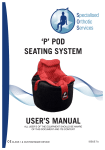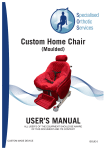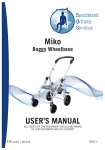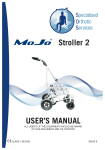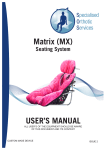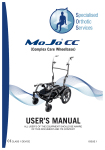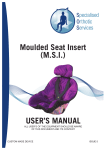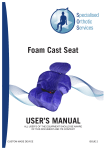Download USER'S MANUAL GLIDER - Specialised Orthotic Services
Transcript
GLIDER Mobile Base USER’S MANUAL ALL USER’S OF THE EQUIPMENT SHOULD BE AWARE OF THIS DOCUMENT AND ITS CONTENT | CLASS 1 DEVICE ISSUE 5 Index CONTENTS Index PAGE 1 Introduction & Maintenance 2 ‘UNI’ Standard Interface Key Identification Points 3 ‘UNI’ Quick-Lok Interface Key Identification Points 4&5 Manual ‘SWING’ Quick-Lok Interface Key Identification Points 6&8 Powered ‘SWING’ Quick-Lok Interface Key Identification Points 7&8 1.0 User’s Guide “Preparing ‘UNI’ Glider For Use” 1.1 Attaching & Releasing the Standard Interface 9 1.2 Attaching & Releasing the Quick-Lok Interface 10 1.3 Tilt Operation 11 2.0 User’s Guide “Preparing Manual ‘SWING’ Glider For Use” 2.1 Attaching & Releasing the Quick-Lok Interface 12 2.2 Manual Tilt & Height Operation 13 3.0 User’s Guide “Preparing Powered ‘SWING’ Glider For Use” 3.1 Attaching & Releasing the Quick-Lok Interface 14 3.2 Powered Tilt & Height Operation 15 3.3 Charging Battery 16 If You Detect a Fault or Breakage 17 CONTACT DETAILS 1 Backpage GLIDER MOBILE (Class 1 Device) Introduction • This Users Guide for the Glider Mobile is designed to give guidance on its use and • • • • maintenance. The Glider Mobile is designed to use a SOS interface system when using special seating systems. This manual is intended for use ONLY in conjunction with the Seating System handbooks that came with your equipment. The maintenance and safety instructions described in the manual must be adhered to. By following these instructions you will be ensuring correct use of the Wheelbase and its safety in use. It is also important to read the ‘Seating System User Manual’ with regard to general use and maintenance. CLEANING • Clean the frame with warm soapy water and towel dry. • Clean the wheels with warm soapy water and towel dry. MAINTENANCE • Check for any signs of wear or damage on a daily basis. • Periodically check & adjust operation of foot brakes. • Periodically check all fixings for tightness. 2 1. KEY IDENTIFICATION POINTS • SOS ‘UNI’ Gliders are provided with a tilting frame (Fig.1.1) and a seating system interface. 1.1. ‘UNI’ STANDARD INTERFACE 6 5 1 4 2 3 Fig.1.1 ‘UNI’ Glider Mobile 1. Tilt Base 2. Wheelbase 3. Foot Brake (x4) 4. Tilt Lever 5. Interface Front Location 6. Interface Rear Location 3 1. KEY IDENTIFICATION POINTS (Cont.) • SOS ‘UNI’ Gliders are provided with a tilting frame (Fig.1.2) and a seating system interface. 1.2. ‘UNI’ QUICK-LOK INTERFACE 1 6 5 7 4 2 3 Fig.1.2 ‘UNI’ Glider Mobile 1. 2. 3. 4. 5. Interface Front Location 6. Interface Rear Location 7. Interface Release Handle Tilt Base Wheelbase Foot Brake (x4) Tilt Lever 4 1. KEY IDENTIFICATION POINTS (Cont.) 1.3. ‘UNI’ SEATING SYSTEM INTERFACE 4 3 3 2 1 5 2 Fig.1.3 1. Frame 2. Front Location (x2) 3. Rear Catch (x2) 4. Release Handle 5. Offset Spigot Assembly (x4) 5 1. KEY IDENTIFICATION POINTS (Cont.) • SOS Manual ‘SWING’ Gliders are provided with a tilting frame, manual height adjustment (Fig.1.4) and a seating system interface. 1.4. MANUAL ‘SWING’ QUICK-LOK INTERFACE 1 4 6 7 8 2 5 3 Fig.1.4 Manual ‘SWING’ Glider Mobile 1. 2. 3. 4. 5. 6. 7. 8. Tilt Base Wheelbase Foot Brake (x4) Seat Recline Lever 6 Height Lever Interface Front Location Interface Rear Location Interface Release Cable 1. KEY IDENTIFICATION POINTS (Cont.) • SOS Powered ‘SWING’ Gliders are provided with a tilting frame, powered height adjtment (Fig.1.5) and a seating system interface. 1.5. POWERED ‘SWING’ QUICK-LOK INTERFACE 1 5 4 7 6 8 9 2 3 Fig.1.5 Powered ‘SWING’ Glider Mobile 1. 2. 3. 4. 5. 6. 7. 8. 9. Tilt Base Wheelbase Foot Brake (x4) Seat Recline Lever Height Controller 7 Interface Front Location Interface Rear Location Interface Release Cable Battery Cover 1. KEY IDENTIFICATION POINTS (Cont.) 1.6. ‘SWING’ SEATING SYSTEM INTERFACE 2 3 4 3 2 Fig.1.6 1. Frame (not shown) 2. Front Location (x2) 3. Rear Catch (x2) 4. Release Cable 1.7. THE SEATING SYSTEM • Seating Systems need to be interfaced to the Glider safely and it is important that • • the interface system supplied with the Glider is used in conjunction with any retention straps supplied with your seating system. Under NO circumstances should a seating system be attached to the Glider without the interface supplied unless written permission has been obtained from SOS. Please refer to any handbooks supplied with your seating system before attaching it to the Glider. 8 USER GUIDE 1.0 PREPARING THE ‘UNI’ GLIDER FOR USE WITH STANDARD INTERFACE 1.1. ATTACHING THE INTERFACE • Make sure that all four foot brakes are • • applied to the wheels (Fig.1.1a). Locate the front bar on the seating system into the interface front location (Fig.1.1b). Lower the seating system back bar into the interface rear location (Fig.1.1c), rotate the two clips into place. Note: clips may be attached to glider or seating system. Fig.1.1b Fig.1.1a Fig.1.1c RELEASING THE INTERFACE • Make sure that all four foot brakes are applied to the wheels (Fig.1.1a). • SOS recommend that the client is removed from the seating system before releasing • the interface. Rotate the two clips (Fig.1.1c) clear of the bar and lift the seat clear of the front location. Note: clips may be attached to glider or seating system. 9 USER GUIDE 1.0 (Cont.) PREPARING THE ‘UNI’ GLIDER FOR USE WITH QUICK-LOK INTERFACE 1.2. ATTACHING THE INTERFACE • • • • Make sure that all four foot brakes are applied to the wheels (Fig.1.2a). Locate the front of the interface frame into stops as shown (Fig.1.2b). Lower the interface into the rear catches as shown until it clicks into position (Fig.1.2c). Please refer to handbooks supplied with your seating system for any additional security devices (i.e. Retaining Straps) that need to be fitted prior to client use. Fig.1.2b Fig.1.2a Fig.1.2c RELEASING THE INTERFACE • Make sure that all four foot brakes are • • • applied to the wheels (Fig.1.2a). SOS recommend that the client is removed from the seating system before releasing the interface. Remove any additional security devices as specified in your seating system handbook. Squeeze the interface lever (Fig.1.2d) until the catches release, raise up the rear of the interface clear of the catches, release the lever and pull the interface clear of the front stops. 10 Fig.1.2d 1.3. TILT OPERATION • Make sure that four foot brakes are applied to the • • • • wheels (Fig.1.3a). Make sure seating system and user are in place. Undo and remove the padlock from the lockout bracket. (Fig.1.3b). Remove the lockout bracket from behind the lever (Fig.1.3c). Note position for refitting. Place one hand on the rear seat mounting cross beam for standard interface (Fig.1.3d) or the Fig.1.3a seat for Quick-Lok interface, squeeze the lever and gently lower/raise the seating system until desired angle of tilt is achieved then release the lever (Fig.1.3e). Replace lever lockout bracket and padlock after adjustment to prevent accidental operation. Fig.1.3b Fig.1.3c Fig.1.3d Fig.1.3e 11 USER GUIDE 2.0 PREPARING THE MANUAL ‘SWING’ GLIDER FOR USE WITH QUICK-LOK INTERFACE 2.1. ATTACHING THE INTERFACE • • • • Make sure that both foot brakes are applied to all four wheels (Fig.2.1a). Locate the front of the interface frame into stops as shown (Fig.2.1b). Lower the interface into the rear catches as shown until it clicks into position (Fig.2.1c). Please refer to handbooks supplied with your seating system for any additional security devices (i.e. Retaining Straps) that need to be fitted prior to client use. Fig.2.1b Fig.2.1a Fig.2.1c RELEASING THE INTERFACE • Make sure that both foot brakes are applied • • • to all four wheels (Fig.2.1a). SOS recommend that the client is removed from the seating system before releasing the interface. Remove any additional security devices as specified in your seating system handbook. Pull the interface cable (Fig.2.1d) until the catches release, raise up the rear of the interface clear of the catches, release the cable and pull the interface clear of the front stops. 12 Fig.2.1d 2.2. TILT & HEIGHT OPERATION • Make sure that both foot brakes are applied • • • to all four wheels (Fig.2.2a). Make sure seating system and user are in place. To tilt the seat, squeeze the lever and gently lower/raise the seating system via the push handle until desired angle of tilt is achieved then release the lever (Fig.2.2b). To Raise/lower height, place both hands on the push handles & push down on the foot pedal (Fig.2.2c), raise/lower upper frame until desired height is achieved then release the pedal. Fig.2.2b Fig.2.2a Fig.2.2c 13 USER GUIDE 3.0 PREPARING THE POWERED ‘SWING’ GLIDER FOR USE WITH QUICK-LOK INTERFACE 3.1. ATTACHING THE INTERFACE • • • • Make sure that both foot brakes are applied to all four wheels (Fig.3.1a). Locate the front of the interface frame into stops as shown (Fig.3.1b). Lower the interface into the rear catches as shown until it clicks into position (Fig.3.1c). Please refer to handbooks supplied with your seating system for any additional security devices (i.e. Retaining Straps) that need to be fitted prior to client use. Fig.3.1b Fig.3.1a Fig.3.1c RELEASING THE INTERFACE • Make sure that both foot brakes are applied • • • to all four wheels (Fig.3.1a). SOS recommend that the client is removed from the seating system before releasing the interface. Remove any additional security devices as specified in your seating system handbook. Pull the interface cable (Fig.3.1d) until the catches release, raise up the rear of the interface clear of the catches, release the cable and pull the interface clear of the front stops. 14 Fig.3.1d 3.2. TILT & HEIGHT OPERATION • Make sure that both foot brakes are applied to all • • • four wheels (Fig.3.2a). Make sure seating system and user are in place. To tilt the seat, squeeze the lever and gently lower/raise the seating system via the push handle until desired angle of tilt is achieved then release the lever (Fig.3.2b). To Raise/lower height, make sure the remote handset is plugged into the control unit & the battery charged, press ths corresponding buttons on the controller (Fig.3.2c), raise/lower upper frame until desired height is achieved then release the button. Fig.3.2a Raise Fig.3.2b Fig.3.2c 15 Lower 3.3. CHARGING BATTERY • DO NOT let the battery go completely flat as damage can occur to the battery. • To test the battery: Press either of the buttons on the remote, the battery charge • • • level is shown on the remote (fig.3.3a), if only one light is shown charge the battery immediately. To charge the battery: Unplug the dust cap from the control box, plug the charger into the controller (fig.3.3b) then plug the other end of the cable into the mains. Note: The actuator cannot be operated whilst on charge, 3 bleeps will be heard to warn you that it is on charge when any of the buttons on the remote are pressed. Once the battery is charged (about 3 to 8 hours) unplug the charger from the mains & controller then replace the dust cap. To conserve battery whilst not in use or when the required height is achieved, press the stop button in (fig.3.3c). When you need to operate the remote again, simply rotate the outer ring on the stop switch in the direction shown until it pops up (fig.3.3d). Fig.3.3a Fig.3.3b Fig.3.3c Fig.3.3d 16 IF YOU DETECT A FAULT OR BREAKAGE 1. IF YOU DETECT A FAULT OR BREAKAGE OF THE EQUIPMENT THEN REPORT THIS IMMEDIATELY TO YOUR LOCAL PROVIDER. 2. UNDER NO CIRCUMSTANCES ARE ANY MODIFICATIONS / ALTERATIONS TO BE DONE BY ANYONE OTHER THAN THOSE AUTHORISED TO DO SO BY THE LOCAL PROVIDER RESPONSIBLE FOR ISSUE OF THE EQUIPMENT. 3. ANY SUCH UNAUTHORISED ACTION WILL PLACE THE CLIENT AT RISK. ALWAYS CONTACT YOUR LOCAL PROVIDER WHO WILL THEN AUTHORISE ANY ACTION NECESSARY TO MAINTAIN OR REPAIR THE GLIDER MOBILE. REPAIRS & SERVICE Within the warranty period. All GLIDER mobiles manufactured by Specialised Orthotic Services Ltd. carry a guarantee on the main frames for 36 months and all other parts for 12 months when used normally. If during this period the product becomes defective and needs repair then please contact SOS (contact details on the back of the booklet). You can also contact your local provider regarding any faults requiring attention. Outside the warranty period. For any goods requiring repair or attention after the 12 months period, then assessment can be made as to the cost of the work required to effect the repair. On acceptance of this quotation the work will proceed. Misuse or neglect. The repairs necessary resulting from misuse or neglect, whether within the warranty period or not will be charged for. MEDICAL DEVICES DIRECTIVE 93 / 42 EEC Specialised Orthotic Services Ltd. in compliance with the Medical Devices Directive have an obligation to investigate and take corrective action on defective devices. To assist us with this procedure we would appreciate your assistance in meeting this obligation by informing us as soon as possible and make the device available for inspection as soon as possible having become aware of a defect. We are required to notify the Competent Authority of certain types of incidents within 10 to 30 days. As part of our quality system we have established procedures to deal with such incidences and would appreciate your swift notification to us via our telephone, fax or e-mail details at the end of this users manual. 17 NOTES: 18 If you require further copies of this handout or require further details relating to any of its content, then please contact us (Copyright applies): Unit 127/128, Fauld Industrial Park, Tutbury, Staffordshire. DE13 9HS. Tel: 01283 520400 Fax: 01283 520401 E-mail: [email protected]




















